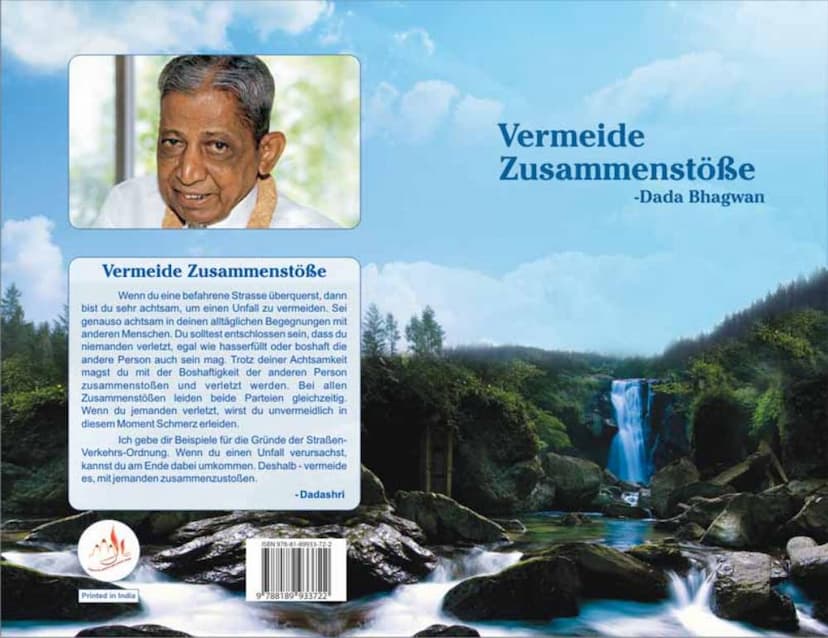Vermeide Zusammenstobe In German Language
Added to library: September 2, 2025

Summary
Here is a comprehensive summary of the Jain text "Vermeide Zusammenstöße" (Avoid Clashes) by Dada Bhagwan, translated from German:
Core Message: Avoid Clashes for Peace and Liberation
The central theme of this book is the paramount importance of avoiding conflict and clashes in all aspects of life to achieve inner peace, harmony, and ultimately, spiritual liberation. Dada Bhagwan likens the caution required when crossing a busy street to the mindfulness needed in daily interactions with others. The fundamental principle is a firm resolve not to hurt anyone, regardless of how hateful or malicious the other person may be.
Key Principles and Analogies:
- Street Safety Analogy: Just as one is cautious to avoid accidents on a busy road, the same vigilance should be applied to human interactions. The consequence of causing an accident can be severe, even fatal. Similarly, causing conflict, even unintentionally, leads to suffering for both parties.
- The Nature of Conflict: Clashes are described as inherent to the world, existing as "vibrations." The world is said to be created and sustained by conflict, and revenge perpetuates it. Every living being carries the potential for revenge.
- The "Wall" Analogy: People with whom one clashes are compared to walls or immovable objects. Running into a wall leads to self-inflicted injury. Similarly, colliding with people in conflict is a result of one's own actions or perceptions. The fault lies with the one who gets hurt, not the "wall." One should be wise enough to go around the obstacle, not into it.
- Internal vs. External Conflict: While external conflicts can be physical, the most damaging are those that occur internally, affecting the mind and intellect. These subtle conflicts can hinder spiritual progress for thousands of lifetimes.
- The Cause of Conflict is Ignorance: Clashes arise from one's own ignorance and inner weaknesses. The text emphasizes that people don't inherently cause differences in opinion; these differences stem from one's own errors in understanding and perception.
- The Role of Ego: The ego is identified as a significant driver of conflict. Trying to assert one's own intellect or opinions often leads to clashes.
- Pratikraman as the Solution: The primary spiritual tool recommended to resolve conflicts and their underlying causes is Pratikraman. This involves a three-part process:
- Alochana (Confession): Acknowledging one's faults.
- Pratikraman (Apology): Sincerely asking for forgiveness.
- Pratyakhyan (Renunciation): A firm commitment to never repeat the mistake. The "Nine Kalams" (inner intentions) provided are a powerful form of Pratikraman.
- Understanding Vyavasthit (Causality): While conflicts may seem to arise due to external circumstances (Vyavasthit), the text stresses that using Vyavasthit as an excuse before a conflict occurs is an abuse of this knowledge. Vyavasthit is only recognized after a conflict has happened and one has tried to avoid it.
- Spiritual Energy and Conflict: Conflicts are depicted as significant drains of spiritual energy. Avoiding conflict preserves and cultivates this energy, leading to greater spiritual progress.
- The "Fault of the Sufferer": A core principle is that "the fault lies with the sufferer." This means that if you are hurt or in conflict, the root cause lies within you, stemming from past karmic accounts that are now manifesting.
- Pratikraman is the only weapon: For resolving these internal accounts and preventing future conflicts, Pratikraman is presented as the ultimate and only effective tool.
- Sexuality as a root of conflict: The text suggests that sexual attraction and its influence are a primary root cause of many conflicts, especially in relationships. Overcoming sexual desires leads to a reduction in conflict.
- Levels of Conflict: The text outlines different levels of conflict: gross (visible to others), subtle (mental), subtler (seeing faults in others after gaining knowledge), and subtlest (deep identification with the body/self, like with "Chandubhai"). Pratikraman is essential for resolving all these levels.
- Healthy Common Sense: Genuine common sense is described as the ability to remain calm, stable, and considerate, especially when others are in conflict with you. This common sense is seen as universally applicable.
Dada Bhagwan's Philosophy and Heritage:
The book introduces Dada Bhagwan (Ambalal M. Patel) as a Gnani Purush who attained self-realization in 1958. His teachings are based on Akram Vignan (the stepless path), a direct and rapid path to self-knowledge. The book mentions that Dada Bhagwan's teachings are continued by his successors, Dr. Niruben Amin and currently Pujya Deepakbhai Desai, who also carry the spiritual energy and knowledge to help others achieve self-realization.
In essence, "Vermeide Zusammenstöße" offers a profound spiritual guideline: by consistently striving to avoid conflict through self-awareness, understanding the root causes of clashes, and diligently practicing Pratikraman, individuals can cultivate inner peace, prevent the depletion of their spiritual energy, and pave a clear path towards ultimate liberation.